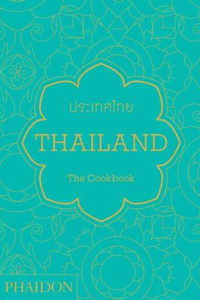
The stunning colors of saffron and orange draped on a cord drying in the wind are echoed in the color of brick or the deep hues of a Spicy Sauce with Boiled Eggs. Think of Thailand: The Cookbook (Phaidon 2014) as a photographic guidebook with an encyclopedia of recipes all from Jean-Pierre Gabriel. This is a book that explores Thai cuisine both visually and sensually. The photographs alone or the recipes alone are great reasons to buy the book – but together, they represent an meditation on Thai food that goes far beyond your favorite Thai restaurant.
 Thai cuisine has more salads then the ordinary green papaya salad (p. 152) offered at most restaurants. Instead of making the same old pasta salad or rice salad for a barbecue, leaf through the Salads chapter for some ideas. Thai Rice Salad (p. 125) comes with side dishes like yard-long beans, chili powder, and sour green mango to punch up the flavor of jasmine rice, shrimp, and coconut – all flavored in a sauce of Thai fish sauce, palm sugar, lemongrass, kaffir lime leaves, and galangal. Glass Noodle Salad (p. 135) has pork, fish cakes and balls, and squid. If you are thinking of Baba ganoush, why not try one of the Spicy Eggplant Salads (pp. 139 and 140) one for long green eggplant and the other for round eggplant. Both are pungent with chiles, pork, and fish sauce. You can end with a Spicy Strawberry Salad (p. 157) with dried shrimp, garlic, and red bird’s eye chiles. Missing are head notes describing where he learned the recipe or how it is traditionally eaten. Yet the photographs are so vibrant – like one of purple flowers, and green vegetables ready to mix into Mango Salad with Smoked Dried Fish (p. 154) – that they make up for the lack of story. The story is in the photos and the flavors.
Thai cuisine has more salads then the ordinary green papaya salad (p. 152) offered at most restaurants. Instead of making the same old pasta salad or rice salad for a barbecue, leaf through the Salads chapter for some ideas. Thai Rice Salad (p. 125) comes with side dishes like yard-long beans, chili powder, and sour green mango to punch up the flavor of jasmine rice, shrimp, and coconut – all flavored in a sauce of Thai fish sauce, palm sugar, lemongrass, kaffir lime leaves, and galangal. Glass Noodle Salad (p. 135) has pork, fish cakes and balls, and squid. If you are thinking of Baba ganoush, why not try one of the Spicy Eggplant Salads (pp. 139 and 140) one for long green eggplant and the other for round eggplant. Both are pungent with chiles, pork, and fish sauce. You can end with a Spicy Strawberry Salad (p. 157) with dried shrimp, garlic, and red bird’s eye chiles. Missing are head notes describing where he learned the recipe or how it is traditionally eaten. Yet the photographs are so vibrant – like one of purple flowers, and green vegetables ready to mix into Mango Salad with Smoked Dried Fish (p. 154) – that they make up for the lack of story. The story is in the photos and the flavors.
Thailand: The Cookbook also includes a chapter of Guest Chefs recipes. These are sophisticated recipes from Thai restaurants around the world that add another dimension to the book. Perhaps the most innovative and interesting recipes are in the Desserts chapter. Savory ingredients like shrimp, corn, shallots and black beans appear in sweet dishes that have lyrical names like Golden Egg Teardrops (p. 422) or Job’s Tears and Young Coconut Porridge (p. 425).
